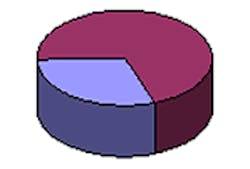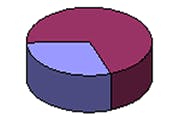Personal Lighting Control Can Increase Worker Satisfaction and Motivation
By Craig DiLouieA new field simulation study conducted by the Light Right Consortium indicates that workers may be more motivated and satisfied when they have the capability to dim and brighten their lighting to their own preference. In addition, personal lighting control represents a new source of energy savings. The Consortium made two major conclusions: Occupants appreciate quality lighting and have preferences that are consistent with their predictions and prior research.There is a strong indicator of increased motivation associated with occupants having personal control over their own lighting.Lighting & Productivity RecapWe know that lighting affects people psychologically and physiologically. Between 80 and 85 percent of our impressions of the world are visual: Light makes sight. Perception, however, depends on how a space is lighted: Lighting makes perception. And perception, as the saying goes, is electric - created, designed, and controlled by humans.The lighting design profession has long claimed that some lighting approaches are better than others – giving rise to the term “lighting quality,” and that better approaches can lead to greater worker morale and satisfaction along with improved corporate image, tenant/employee attraction and retention, building valuation, security, retail sales, etc. Today, it is more difficult to assess worker output (the proverbial “widgets per hour”) in offices, making worker satisfaction and motivation a more important metric of productivity than it was once considered years ago:A study in the Journal of Occupational Health Psychology reported that job satisfaction accounted for 63 percent of variance in organization commitment, which accounted for 80 percent variance in intent to turnover. In that study, job satisfaction incorporated satisfaction with the physical environment. In a survey of owners, facilities managers and other market participants conducted by the Light Right Consortium, respondents reported employee/occupant satisfaction to be even more important than worker output, retention, and absenteeism. Workplace design is being found to be a major contributing factor to how satisfied and motivated workers are:A 1987 study in the Journal of Applied Psychology reported that workplace characteristics accounted for a 31 percent variance in work satisfaction. BOSTI Associates, a firm that researches the office’s effects on productivity and job satisfaction, reported in 2000 that the workplace makes a 3-10 percent (“smallest” to “largest”) contribution to individual performance, 6-15 percent contribution to team performance, and an 8-32 percent contribution to job satisfaction – according to a survey of about 31,000 people. While owners may be interested in better lighting, they may not actually choose to install it unless they believe that lighting can be measurably beneficial for their workforce. The three (interrelated) barriers to adoption of quality lighting are initial cost, a lack of scientific evidence of the link between lighting quality and human performance, and the ability to predict financial benefits of increases in occupant satisfaction.The Light Right Consortium was formed in 1998 to tackle the problem.The Field Simulation StudyA landmark study was established to address the question, “Can different forms of realistic office lighting affect the performance of office work or the well-being of employees?” The primary variables to be studied included room surface brightness and personal control. The results are extraordinary, particularly in regards to giving occupants the ability to dim and brighten their own lighting to individual preference. The study indicated that personal dimming control, in particular, can result in occupants performing better on certain productivity metrics.The research centered on a field simulation study, conducted in the field but with simulated tasks and a high degree of experimental control that is typical of laboratory studies. This approach was chosen to maximize realism and validity of the results. (To confirm the results and gain more information, an actual field study is planned for 2003/2004.) An office in Albany, NY, was set up as a typical space for nine workers. The open office plan featured perimeter windows and access to a view, although translucent window shades were used to alleviate the impact of daylight at workstations. The space was planned and furnished to allow the researchers to change the lighting between five different lighting systems without the knowledge of the subjects. The workers were temporaries hired to work under the different lighting conditions for a typical eight-hour day. A range of output measures were collected that ranged from the subjective (occupant opinion) to objective (quantitative performance), resulting in a large data set. The five lighting scenarios included:Best Practice: Linear system of direct/indirect fixtures together with wall-washing to brighten the walls.Switching Control: The same as best practice but with a moveable desk lamp having three manually switched light outputs and providing some individual control.Dimming Control: Direct/indirect fixtures suspended over the center of each cube, together with wall-washing system. The direct component of each could be dimmed using the interface on the occupant’s computer.Parabolic Base Case: Regular array of three-lamp parabolic-louvered fixtures.Lensed Troffer Base Case: Regular array of lensed troffers.The temporaries worked for a complete day on set tasks to simulate elements of office work, and on questionnaires linked to the productivity metrics being studied. When asked whether they agreed with the following statements at the end of the day, the workers responded:“Overall, the lighting is comfortable.” Direct/indirect with Dimming Control 91%Parabolic Base Case 71%“The lighting is uncomfortably bright for the tasks that I perform.”Direct/indirect with Dimming Control11%Parabolic Base Case 33%Figure 1. Direct/Indirect and personal control systems show higher levels of comfort and acceptability, based on the percentages of people who found the lighting to be “comfortable” overall. Direct Only (Troffers): 70%Direct/Indirect + Personal Control: 90%Direct/Indirect + Personal Control: 90%
Personal dimming control with linear suspended direct/indirect fixtures yielded a 30-point spread in response to whether the workers believed the lighting was comfortable, and produced the lowest incidence of workers perceiving their lighting to be uncomfortably bright for the tasks they performed. In the objective segment of the research, the Light Right Consortium discovered that the presence of control had a measurable impact on motivation, which in turn was represented in the study in measures of persistence and vigilance. (Persistence at a difficult or impossible task is an indicator of motivation at the task; people who are not motivated to do the task will not continue at it when it becomes very difficult. Vigilance is a state of watchfulness or careful attention, and is related to accuracy.) The study subjects were more able to sustain their persistence and vigilance over the day in the personal dimming scenario compared to the baseline and best practice conditions (see Figure 2).Figure 2. Occupants with dimming control experienced increased motivation and were able to sustain their persistence and vigilance over time, compared to those without any control of the lighting.
The probable reasons for this included:
The ability to fine-tune the lighting conditions to meet the needs of individuals, both with respect to horizontal light levels and the brightness on the surrounding partitions.The ability to satisfy the preferences of individuals – the function of satisfaction in the workplace.The psychological impact of control on motivation.Besides increasing satisfaction and motivation, personal dimming control can also result in cumulative energy savings that can add up over time to significant cost savings.It seems that personal dimming is a trend that is catching on. In a recent Watt Stopper study conducted by Ducker Research, occupant control was identified as a major trend by owners and specifiers; respondents were then asked another question related to price sensitivity to more sophisticated lighting options.A choice was provided: Given the installed cost for a traditional parabolic system is $2.00 per square foot, which of the following three options would they elect to use to improve lighting quality? #1Use a direct/indirect fixture for $2.50/sq.ft. installed40.3%#2Integrate occupancy sensors for $3.00/sq.ft. installed31.3%#3Integrate occupancy sensors and provide personal dimming control for $3.50/sq.ft. installed25.4%Option #1 was desirable to respondents primarily because it represents a lower initial cost.Option #2 was desirable primarily because it is “cost effective, a good value.” Option #3 was desirable primarily because it increases occupant comfort. The implication of the positive response to personal dimming control is that a significant segment of the market would pay a premium of $0.50 per square foot for it.More InformationFor more information about the Light Right Consortium’s study, visit www.lightright.org.
The ability to fine-tune the lighting conditions to meet the needs of individuals, both with respect to horizontal light levels and the brightness on the surrounding partitions.The ability to satisfy the preferences of individuals – the function of satisfaction in the workplace.The psychological impact of control on motivation.Besides increasing satisfaction and motivation, personal dimming control can also result in cumulative energy savings that can add up over time to significant cost savings.It seems that personal dimming is a trend that is catching on. In a recent Watt Stopper study conducted by Ducker Research, occupant control was identified as a major trend by owners and specifiers; respondents were then asked another question related to price sensitivity to more sophisticated lighting options.A choice was provided: Given the installed cost for a traditional parabolic system is $2.00 per square foot, which of the following three options would they elect to use to improve lighting quality? #1Use a direct/indirect fixture for $2.50/sq.ft. installed40.3%#2Integrate occupancy sensors for $3.00/sq.ft. installed31.3%#3Integrate occupancy sensors and provide personal dimming control for $3.50/sq.ft. installed25.4%Option #1 was desirable to respondents primarily because it represents a lower initial cost.Option #2 was desirable primarily because it is “cost effective, a good value.” Option #3 was desirable primarily because it increases occupant comfort. The implication of the positive response to personal dimming control is that a significant segment of the market would pay a premium of $0.50 per square foot for it.More InformationFor more information about the Light Right Consortium’s study, visit www.lightright.org.



